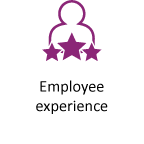Employee Benefits Insights
Resources to Help HR Meet the Changing Needs of Organizations
NOVEMEBER 2, 2021
Human resources (HR) professionals are continually challenged to do more with less. According to a survey of 2,000 organizations by the Society for Human Resources Management (SHRM), the HR-to-employee ratio was 2.57 HR professionals per 100 employees in 2014.1 The report also revealed that the HR-to-employee ratio doesn’t increase at the same rate as an organization’s growth. In 2018, Bloomberg Law surveyed 700 employers and found that the HR-to-employee ratio was only 1.5 HR professionals per 100 employees.
Although SHRM hasn’t yet conducted a post-COVID-19 survey on the HR-to-employee ratio, it’s clear that HR teams are continuing to shrink and being asked to do more with less when compared to other areas within organizations.
HR professionals have traditionally held a wide breadth of corporate responsibilities such as employee recruitment and retention, learning and development, payroll, compensation, benefits, labor relations, compliance, and health and safety.2 With the onset of the COVID-19 pandemic, HR professionals faced a new set of challenges. Whether implementing remote work procedures, interpreting the Centers for Disease Control and Prevention (CDC) guidelines on creating safe work environments, planning return-to-work protocols or considering COVID-19 vaccination policies, responsibilities for HR professionals shifted monumentally.3
What’s Ahead for Human Resources in 2022?
As we head toward the new year, HR professionals are expected to work with C-suite executives on strategic initiatives while maintaining responsibility for administrative corporate tasks. A joint survey of HR professionals by Future Workplace, Lyra Health and the Boston University Questrom School of Business Human Resources Policy Institute (HRPI) showed that the top 5 priorities for HR departments are:4





Human Resources: Doing More With Less
Going forward, organizations will continue to ask HR teams to do more with fewer resources. A 2021 Gartner HR Budget and Staffing Survey reported that 34% of HR leaders plan to decrease their HR function budgets.5 As a result, HR professionals will likely lean more on their benefits brokers and technology vendors to help manage their workloads. Unfortunately, most brokers and technology vendors are not equipped to provide such dedicated support to organizations.
Resources to Help HR Professionals
Employees and their dependents often seek out the HR department to ask questions about their benefits or for assistance with a claims issue. These types of tasks take up time that HR professionals could devote to more strategic initiatives.
USI Insurance Services realized that companies would be better served with a resource devoted to assisting employees and their dependents. To meet this need, we created the USI Benefit Resource Center (BRC), a dedicated call center for clients staffed by 40 employee benefit specialists from across the U.S. providing service from 8 a.m. to 5 p.m. local time. BRC specialists are prepared to:
- Answer benefits questions for all lines of coverage
- Assist with eligibility and claims issues with insurance carriers
- Provide claim appeals information and assistance
In addition to the BRC, USI also created the USI mobile app, which provides employees and dependents with:
- 24/7 access to benefits guides
- Summary of benefits and coverage (SBC) documents
- Carrier contact information
The app can be customized to include videos on how an organization’s benefits work, as well as digital images of insurance ID cards.
For HR professionals looking to streamline their administrative tasks, USI also provides additional support. For instance, USI’s HR Technology Consulting team can help an organization select HR technology that best fits their needs, as well as assist them to cover platform costs with the USI Tech Credit Program (TCP). A human capital management (HCM) or benefits administration platform can streamline and improve repetitive tasks related to payroll, benefits enrollment and onboarding, creating more time for HR professionals to spend on strategic projects.
HR professionals work closely with their USI account teams throughout the year to manage benefits and to implement changes to enhance coverage and control benefits costs. To help HR teams keep track of the various deliverables and deadlines they manage, USI creates custom service calendars.
USI clients also have access to the Mineral HR suite that includes advanced HR knowledge and training resources organizations can use to build and maintain compliant and productive workplaces.
If you’d like to learn more about how USI tools and resources for HR professionals can help your organization in 2022, contact your local USI benefits consultant or email ebsolutions@usi.com.
Sources:
1 Culture Amp. 2021. Determining your HR to employee ratio.
2 Gonzalez, E., 2021. The 8 Key Functions of Human Resources Management.
3 SHRM. 2021. HR Managers Rethink Their Role During the Coronavirus Pandemic.
4 Size, F. and WIRE, B., 2021. New Study: 68% of HR Leaders Prioritize Employee Mental Health: Shifting the Focus from Organizational Priorities to Human Needs.
5 Gartner. 2021. HR Function Budgets Will Reflect Ongoing Priority Shifts in 2021.
SUBSCRIBE
Get USI insights delivered to your inbox monthly.
